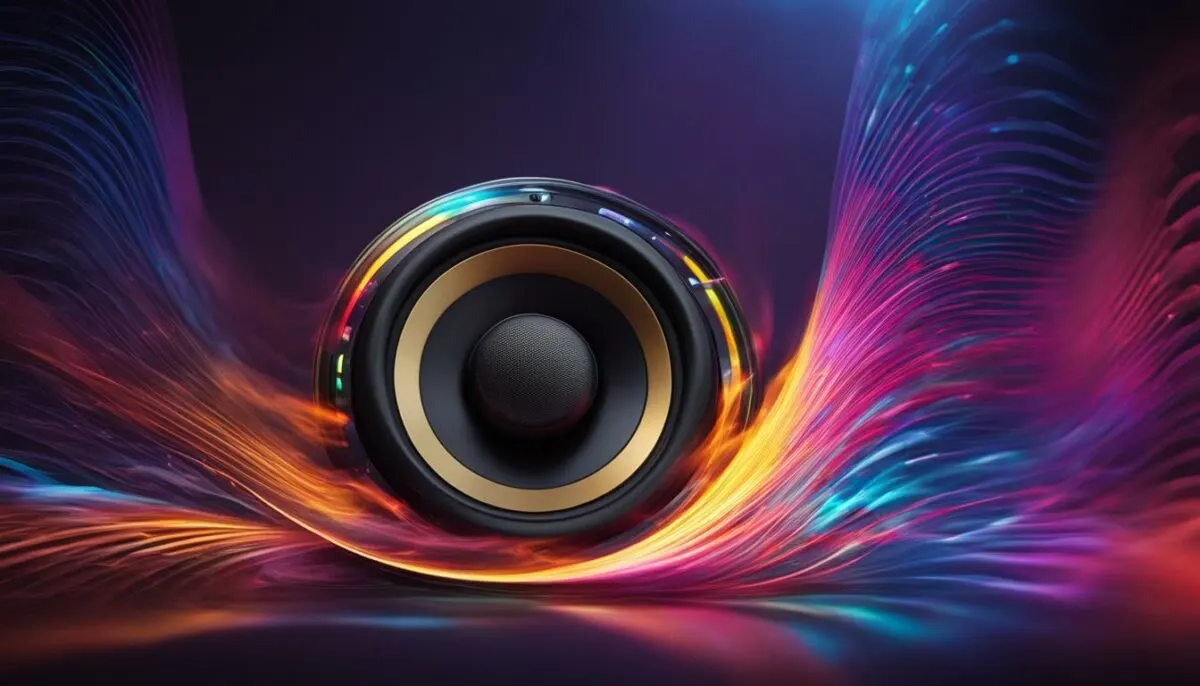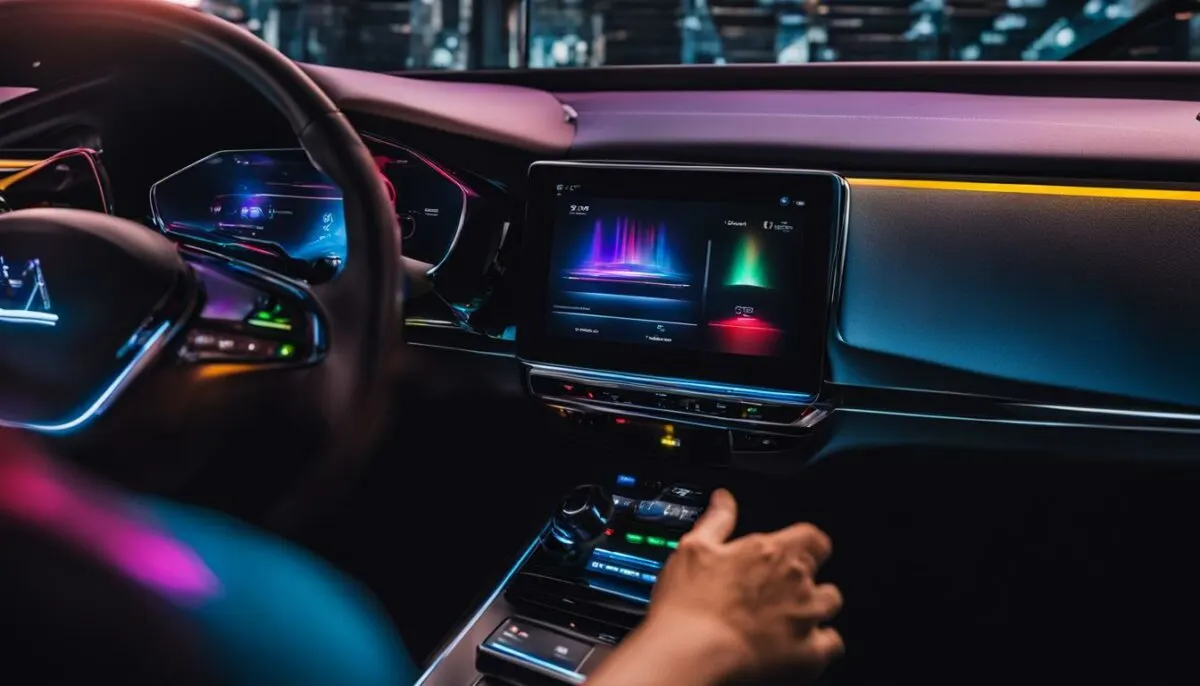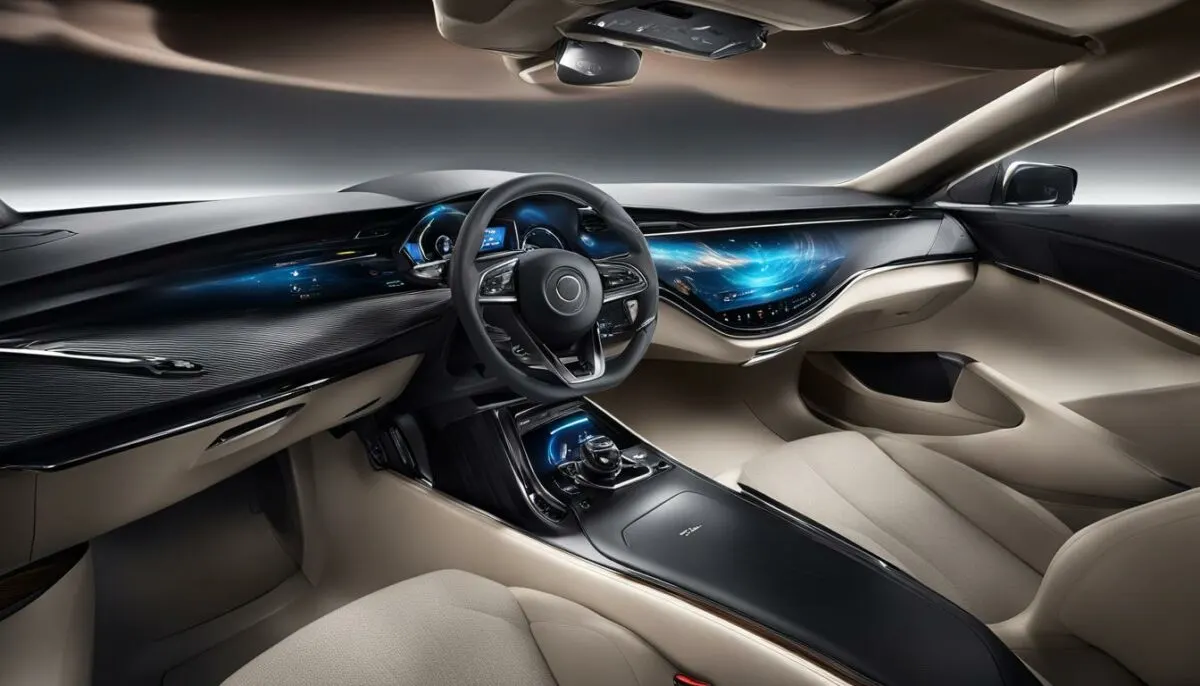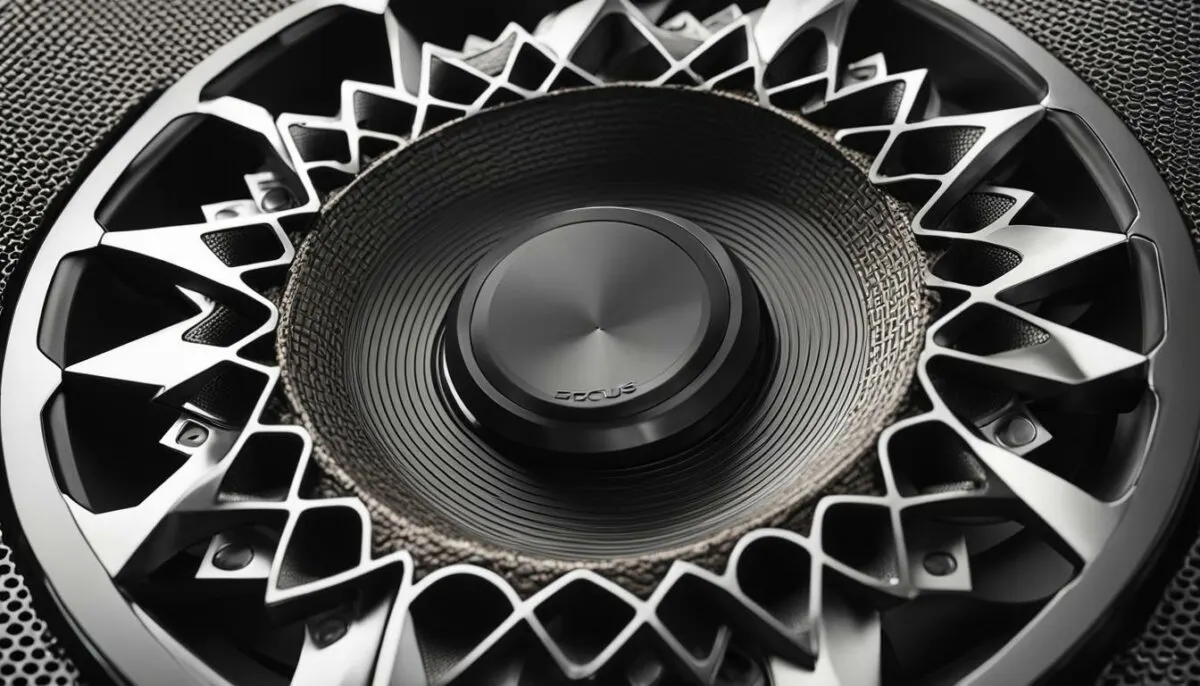When it comes to car audio systems, many people focus on bass and treble, often overlooking the crucial role of midrange frequencies. But what does mid do in a car audio system, and why is it important for achieving high-quality sound reproduction?
Midrange frequencies refer to the range of tones that fall between bass and treble frequencies, typically around 300 Hz to 4 kHz. These frequencies are crucial for achieving clarity and balance in music, as they contain many of the subtle nuances and details that give music its depth and texture.
Whether you’re listening to your favorite album or enjoying a podcast on your daily commute, having well-reproduced midrange frequencies can significantly enhance your overall listening experience. In this article, we’ll explore the importance of mid in car audio systems and ways to optimize its performance for optimal audio quality.
Key Takeaways:
- Midrange frequencies are essential for achieving clarity and balance in music.
- Midrange frequencies fall between bass and treble frequencies and typically range from 300 Hz to 4 kHz.
- Well-reproduced midrange frequencies can significantly enhance your overall listening experience.
- Optimizing midrange performance requires careful consideration of factors such as speaker selection, installation, and sound optimization techniques.
- A balanced and high-quality sound in car audio systems requires the proper reproduction of midrange frequencies.
Exploring Midrange Speakers in Car Audio
If you’re a car audio enthusiast, you know that high-quality sound reproduction starts with the right components. One essential component that plays a crucial role in car audio systems is midrange speakers. These speakers are designed specifically to handle midrange frequencies and are responsible for reproducing sounds such as vocals, guitars, and horns.
Midrange speakers are a vital part of any car audio system. They bridge the gap between high and low frequencies, allowing for a well-balanced and accurate audio experience. Without midrange speakers, your car audio system would sound dull and lacking in detail.
When selecting midrange speakers for your car, it’s essential to consider several factors. These include power handling, sensitivity, and frequency response. High-quality midrange speakers will provide clear, distortion-free audio even at high volumes, making them ideal for music lovers who like to turn up the volume.
It’s also crucial to choose midrange speakers that are compatible with your existing car audio system. This ensures that your new speakers will work seamlessly with your other components to deliver the best possible sound quality.
| Pros of Midrange Speakers | Cons of Midrange Speakers |
|---|---|
|
|
Table: Pros and Cons of Midrange Speakers
Upgrading your car audio system with quality midrange speakers can significantly enhance the overall audio quality, delivering more precise and detailed midrange frequencies. Whether you’re a music lover, audiophile or just appreciate high-quality audio, midrange speakers are a must-have component for any car audio system.
Defining Midrange Frequencies in Car Audio

Midrange frequencies in car audio systems are the tones that fall between high and low frequencies. They typically range from 300 Hz to 5000 Hz and are responsible for producing essential audio elements such as vocals, guitars, and drums. Without midrange frequencies, your car audio system would sound unbalanced, with too much emphasis on either bass or treble.
Midrange frequencies play a vital role in achieving clarity in sound reproduction. They bridge the gap between high and low frequencies, ensuring that every sound is accurately reproduced and well-balanced. To understand the significance of midrange frequencies better, consider the equal loudness contour, which shows how different frequencies are perceived by the human ear at the same sound pressure level. The equal loudness contour for midrange frequencies is relatively flat, indicating that our ears are most sensitive to sounds in this frequency range.
| Frequency range | Sound characteristics |
|---|---|
| 300 Hz – 1000 Hz | Lower midrange frequencies, responsible for vocals and some instruments such as trumpets and saxophones. |
| 1000 Hz – 2500 Hz | Middle midrange frequencies, responsible for guitar and snare drum sounds. |
| 2500 Hz – 5000 Hz | Upper midrange frequencies, responsible for cymbals and some percussion instruments sounds. |
As you can see from the table, midrange frequencies encompass a wide range of sounds that are crucial for fully enjoying music in your car audio system. To ensure optimal performance, it is essential to invest in quality midrange speakers and amplifiers that can accurately reproduce these frequencies.
Defining Midrange Frequencies in Car Audio
In summary, midrange frequencies are the essential frequencies that sit between high and low frequencies in car audio systems. They play a vital role in achieving a balanced and high-quality sound experience, ensuring that every sound is accurately reproduced with clarity and precision. Understanding the significance of midrange frequencies is crucial for selecting the right audio components and optimizing the performance of your car audio system.
The Role of Mid in Balancing Tones

Midrange frequencies play a crucial role in car audio systems by filling the gap between the low and high frequencies. Achieving a well-balanced sound spectrum is essential to ensure an accurate and pleasing listening experience.
The human ear is sensitive to the midrange frequencies of sound, making it critical to reproducing these frequencies correctly. Without quality midrange reproduction, the audio system can sound flat and uninteresting.
“The midrange is where you get the body of the instrument, the thickness of the sound, and the warmth that give the music a human feel. Without midrange, vocals sound weak, guitars lose their strum, and pianos become misshapen.”
As the quote suggests, midrange frequencies bring out the subtleties and nuances in music, making it essential to have a well-balanced car audio system. Quality midrange reproduction can create a more immersive and dynamic sound experience, bringing music to life in a way that low-quality audio systems cannot.
In summary, midrange frequencies play a crucial role in balancing the tones in your car audio system. By correctly reproducing these frequencies, you can achieve a well-balanced sound spectrum that is pleasing to the ears. Upgrading your car audio system with quality midrange speakers and amplifiers can significantly enhance the overall audio quality, delivering more precise and detailed midrange frequencies.
Enhancing Audio Quality with Midrange Speakers

If you’re looking to upgrade your car audio system, investing in quality midrange speakers is an excellent choice to enhance the overall sound quality. These components are crucial for reproducing midrange frequencies, which often get lost in the mix in lower-end audio systems.
Midrange speakers offer several benefits, including:
- Crisper and clearer vocals
- Improved instrument separation
- More precise and detailed sound reproduction
So, how do you choose the right midrange speaker for your car audio upgrade? There are several factors to consider, including:
| Factor | Explanation |
|---|---|
| Power handling | This refers to the amount of power a speaker can handle. Ensure that the speaker’s power handling capacity matches or exceeds the output of your car audio system. |
| Sensitivity | Speakers with high sensitivity require less power to produce the same volume level as those with low sensitivity. Consider your car’s soundproofing and the power output of your amplifier when choosing midrange speakers with the appropriate sensitivity. |
| Frequency response | This is the range of frequencies that a speaker can reproduce. Ensure that the midrange speakers you choose have a frequency response that includes the midrange frequencies that your car audio system lacks. |
Once you’ve chosen the right midrange speakers, it’s time to install them in your car. The installation process may vary depending on your car’s make and model, but here are some general tips:
- Choose the appropriate speaker size for your car.
- Remove the old speakers and clean the mounting surface.
- Connect the wires to the new speakers and secure them in place.
It’s also essential to adapt the new speakers to your existing car audio system to ensure optimal performance. Consider upgrading your amplifier to further enhance the power and clarity of your midrange frequencies.
Enhancing Audio Quality with Midrange Speakers Conclusion
Upgrading your car audio system with quality midrange speakers can significantly enhance your overall listening experience. By choosing the right midrange speakers and installing them correctly, you can enjoy a more precise, detailed, and well-balanced audio experience in your car.
Amplifying the Midrange with Car Audio Amplifiers
If you’re looking to enhance your car audio system’s midrange frequencies, a car audio amplifier may be just what you need.
Car audio amplifiers work by increasing the power of the audio signal sent to your speakers. By doing so, they can improve the clarity and volume of midrange frequencies, providing a more dynamic and immersive sound experience.
Typically, midrange speakers require less power than subwoofers or tweeters, so a dedicated midrange amplifier may not be necessary. Instead, you can use a multi-channel amplifier to power all your car speakers while allocating more power to the midrange speakers.
When selecting a car audio amplifier, it’s essential to consider compatibility and power handling. Ensure that your amplifier matches the power requirements of your midrange speakers, as overpowering or underpowering them can result in damage or sound quality issues.
“Car audio amplifiers can significantly improve the power and clarity of midrange frequencies, allowing you to enjoy a more immersive and dynamic sound experience.”
Another factor to consider is the amplifier’s signal-to-noise ratio (SNR), which measures how much the signal level exceeds the noise level. A higher SNR indicates less background noise and better audio quality.
When installing a car audio amplifier, ensure that you use appropriate wiring and placement. The amplifier should be close to the car battery but away from heat sources to prevent overheating. Additionally, use high-quality RCA cables to minimize signal loss and interference.
Overall, a car audio amplifier can help optimize the performance of your midrange speakers and provide a more balanced and enjoyable audio experience. Just remember to select a compatible amplifier with suitable power handling and installation considerations.
Choosing the Right Midrange Speakers for Your Car

When upgrading your car audio system, selecting the right midrange speakers is crucial to achieving optimal sound quality. Here are some factors to consider when choosing midrange speakers:
| Factor | Description |
|---|---|
| Power Handling | Determine the amount of power, measured in watts, the midrange speakers can handle. Ensure they are compatible with your car’s amplifier and head unit. |
| Sensitivity | Consider the sensitivity rating, which indicates how efficiently the speakers convert power into sound. Speakers with higher sensitivity require less power to produce the same volume. |
| Frequency Response | Look for midrange speakers with a frequency range that covers the midrange frequencies in your car audio system, typically from 250 Hz to 2000 Hz. This ensures accurate reproduction of midrange tones. |
| Speaker Size | Determine the appropriate speaker size for your car’s sound system. Midrange speakers typically range from 3 to 8 inches in diameter. |
| Build Quality | Consider the construction quality of the speakers, including the materials used for the cone, surround, and frame. Quality components ensure durability and long-lasting performance. |
| Brand Reputation | Choose midrange speakers from reputable brands known for producing quality car audio components. Read customer reviews and research the brand’s history and reputation in the industry. |
By considering these factors when selecting midrange speakers, you can ensure optimal performance and sound quality in your car audio upgrade.
Installing Midrange Speakers in Your Car

Once you have chosen the right midrange speakers for your car, the next step is installing them. This process can seem daunting, but with some guidance and patience, you can install them yourself or with the help of a professional.
Speaker Placement
The placement of midrange speakers in your car is critical to achieving optimal sound performance. Typically, these speakers are installed in the door panel or dashboard of the car. However, the location may vary depending on the make and model of your car.
It’s essential to ensure that the speakers are not obstructed by any object that could affect their sound quality, such as air conditioning vents or window mechanisms. Additionally, you should avoid placing the speakers too close to each other, as this can cause distortion in the sound.
Wiring
Wiring the midrange speakers correctly is crucial to achieving optimal sound quality. Make sure to follow the manufacturer’s instructions carefully, as the wiring can vary depending on the make and model of the speakers.
You will need to connect the positive terminal of the speaker to the positive wire in your car, and the negative terminal of the speaker to the negative wire in your car. If you are unsure about the wiring, it’s best to seek the help of a professional.
Adapting to Your Existing Car Audio System
The midrange speakers you choose must be compatible with your existing car audio system. You may need to make some adjustments to your system to ensure they work correctly. If you are unsure about how to do this, seek the help of a professional audio installer.
It’s also essential to ensure that the midrange speakers are correctly balanced with the other speakers in your car audio system. This balance will ensure that the sound is clear and crisp, and you can experience the full potential of your new midrange speakers.
Pro Tip: When installing midrange speakers in a car, it’s best to use high-quality wiring and connectors to ensure a stable and long-lasting connection. This will help to reduce the risk of any interference or distortion in the sound.
Optimizing Midrange Performance in Your Car Audio System

To optimize the performance of midrange speakers in your car audio system, you need to consider several factors. These include:
- Speaker placement: Proper placement of midrange speakers can significantly impact their performance. Place them at ear level for the best listening experience.
- Soundproofing: To reduce external noise and improve clarity, consider adding soundproofing materials to your car doors and trunk.
- Equalization: Proper equalization can make a significant difference in the performance of your midrange speakers. Use an equalizer to adjust the frequencies and balance the sound.
- Sound imaging: Consider adding a sound imaging processor to enhance the soundstage and imaging of your audio system.
In addition to these techniques, you can also upgrade your car audio system to improve the performance of midrange speakers. A car audio upgrade, such as a new head unit, amplifier, and subwoofer, can provide additional power and clarity to your audio system, resulting in a richer and more immersive sound experience.
A car audio upgrade can be a significant investment, but it is essential to choose high-quality components that are compatible with your car audio system to achieve the best results. Look for midrange speakers with a high sensitivity rating to ensure they can handle the power output of your amplifier and provide optimal performance.
Finally, ensure that your midrange speakers are installed correctly. Poor installation can negatively impact their performance and degrade the overall sound quality of your car audio system. If you are unsure about the installation process, seek the assistance of a professional car audio installer.
The Impact of Midrange on Overall Listening Experience

When it comes to car audio systems, midrange frequencies play a crucial role in achieving well-balanced and high-quality sound. But what does mid do in a car audio system, and why is it so important? Let’s explore the impact of midrange on the overall listening experience in more detail.
Firstly, midrange frequencies are responsible for reproducing the most important elements of music, such as vocals, guitars, and drums. These frequencies sit in the middle of the frequency spectrum, between the lower bass and higher treble frequencies. By filling the gap between these two extremes, midrange frequencies help create a more accurate and pleasing audio experience.
The presence of well-reproduced midrange frequencies can bring out the subtleties and nuances in music. For example, a guitar solo can be lost in the mix without proper midrange reproduction, whereas a well-defined midrange can make the solo stand out and be enjoyed at its fullest. Similarly, vocals can sound muddled and unclear without proper midrange reproduction, whereas a well-reproduced midrange can make the vocals crisp and clear, providing a superior listening experience.
Car audio speakers that can accurately reproduce midrange frequencies can significantly enhance the overall audio quality. The use of quality midrange speakers can deliver more precise and detailed midrange frequencies, resulting in a more immersive and dynamic sound experience. Amplifying the power and clarity of midrange frequencies with car audio amplifiers can also improve the listening experience and create a more balanced sound spectrum.
Optimizing the performance of midrange speakers in your car audio system can also help improve the overall listening experience. Techniques such as soundproofing, equalization, and sound imaging can enhance midrange reproduction and further balance the sound spectrum.
In conclusion, midrange frequencies play a vital role in enhancing the overall sound quality of car audio systems, providing a more accurate and pleasing audio experience. Upgrading your car audio system with quality midrange speakers and amplifiers, coupled with techniques to optimize midrange performance, can significantly enhance your overall listening experience.
Conclusion
Now that you understand the significance of midrange frequencies in car audio systems, you can make informed decisions about upgrading and optimizing your audio experience. By incorporating midrange speakers and amplifiers into your vehicle’s audio system, you can achieve a more balanced and immersive sound.
When selecting midrange speakers, pay attention to factors such as power handling, sensitivity, and frequency response to ensure optimal performance. Additionally, take care when installing and optimizing your midrange speakers to achieve maximum sound quality. Consider soundproofing and equalization techniques to further enhance your audio experience.
Remember that a well-reproduced midrange can greatly enhance your overall listening experience. By balancing the sound spectrum, midrange frequencies expose the subtle nuances in music, bringing you closer to the artist’s original intention. Don’t wait to upgrade your car audio system with quality midrange components.
FAQ
What does mid do in a car audio system?
Midrange frequencies in a car audio system play a crucial role in balancing the sound spectrum by filling the gap between low and high frequencies. They contribute to achieving clarity in sound reproduction and enhance the overall audio experience.
What are midrange speakers and why are they important in car audio?
Midrange speakers are car audio components designed to reproduce midrange frequencies. These frequencies are essential for a well-balanced audio experience in a car. Midrange speakers ensure the accurate and precise reproduction of midrange frequencies, resulting in enhanced sound quality.
What are midrange frequencies in car audio?
Midrange frequencies refer to a specific range of frequencies in a car audio system. They typically encompass frequencies between the low bass and high treble ranges. Midrange frequencies contribute to achieving clarity and definition in the sound reproduction, making the audio experience more enjoyable.
How does mid contribute to balancing tones in car audio?
Midrange frequencies help balance the sound spectrum by filling the gap between low and high frequencies. They ensure that no frequency range overpowers the others, resulting in a more accurate and pleasing audio experience. Balancing tones with midrange frequencies creates a well-rounded and balanced sound in car audio systems.
How can midrange speakers enhance audio quality in a car?
Upgrading your car audio system with quality midrange speakers can significantly enhance the overall audio quality. These speakers are designed to deliver more precise and detailed midrange frequencies, improving the clarity and definition of the sound. By reproducing midrange frequencies accurately, midrange speakers enhance the overall listening experience in a car.
What is the role of car audio amplifiers in amplifying the midrange?
Car audio amplifiers play a crucial role in boosting the power and clarity of midrange frequencies. They amplify the audio signal, allowing the midrange frequencies to be heard more prominently. This amplification enhances the immersive and dynamic sound experience in a car audio system.
How do I choose the right midrange speakers for my car?
When selecting midrange speakers for your car, consider essential factors such as power handling, sensitivity, and frequency response. Power handling determines the speaker’s ability to handle power without distortion, sensitivity refers to how loud the speakers can get with a given amount of power, and frequency response indicates the range of frequencies the speakers can accurately reproduce. Choosing speakers that match your car’s specifications and your audio preferences ensures optimal audio performance.
What are the steps involved in installing midrange speakers in a car?
Installing midrange speakers in your car involves several steps. Start by identifying the ideal speaker placement that ensures optimal sound coverage. Then, remove any existing speakers and prepare the mounting location for the new midrange speakers. Next, wire the speakers correctly and make the necessary connections to your car audio system. Finally, adapt the midrange speakers to your existing car audio setup by adjusting the settings and ensuring compatibility with other components.
How can I optimize the performance of midrange speakers in my car audio system?
To optimize the performance of midrange speakers in your car audio system, consider techniques such as soundproofing the car to minimize external noise interference, using equalizers to fine-tune the sound output, and employing sound imaging techniques to enhance the soundstage. These additional measures can further enhance the overall audio experience and maximize the potential of your midrange speakers.
How does midrange impact the overall listening experience in a car audio system?
Well-reproduced midrange frequencies significantly enhance the overall listening experience in a car audio system. By bringing out the subtleties and nuances in music, midrange frequencies add depth and richness to the sound. They contribute to a more detailed and immersive audio experience, allowing you to fully appreciate the intricacies of your favorite songs.